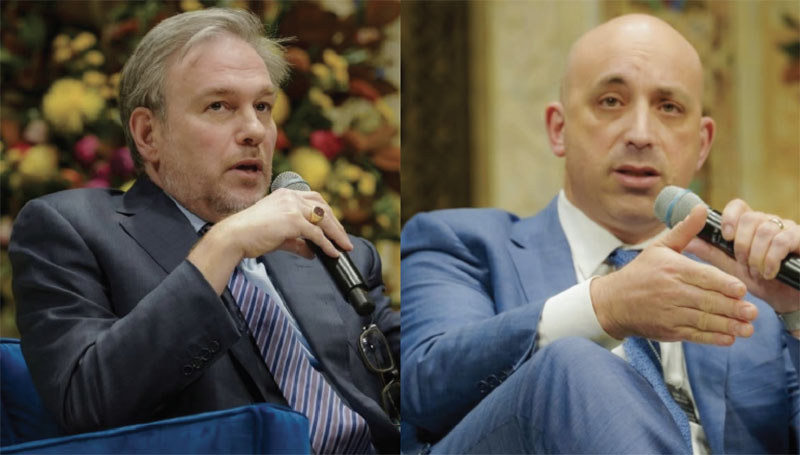My mother is87. Or is it 90? As long as I can remember, I thought that she hadbeen born in 1910, was named Miriam Euffa, and brought here from Kievas a 5-year-old by parents who were educated, and who had been partof what must have been a turn-of-the-century minority: theRussian-Ukrainian Jewish professional class. Now Medicare tells methat her Social Security card lists her year of birth as 1907.
At this point, I ask myself, what difference canit make? My mother has Alzheimer’s. The disease has ushered her intoa realm where days, weeks, years hardly seem to matter. Until just afew days ago, she resided in Cedars-Sinai Medical Center, where shewas recovering from pneumonia (which she apparently contracted aftershe broke her hip and underwent surgery at Midway Hospital inJanuary, followed by three weeks of physical therapy at the BeverlyHills Rehabilitation Center in February).
Thanks to her two-month period of extended stay inthese three separate medical facilities, I have become knowledgeable(and dismayed) about hospital life for the elderly. I have watched mymother move rapidly from living as a woman who was mobile,semi-independent and trapped in the early stages of Alzheimer’s tosomeone who is now a patient, stripped bare, functioning in a stateof helplessness, or what a doctor described as delusionalpsychosis.
Is this a natural decline, one in which the bodymalfunctions and the Alzheimer’s mind quickly follows suit? Or is it,in some large measure, a fallout from our cutting-edge,multimillion-dollar corporate hospital system? I have come to believethat this health-care system, with the best intentions in the world,failed me and the aging parent I turned over to their highlyspecialized care.
I know, this could just be my way of release, anexpression of despair, depression and, yes, an underlying ragebursting through after months of frustration. My mother enteredCedars because she had been overmedicated and had become highlyagitated. Once she was admitted, Cedars’ proficient medical expertisecame into play: Tests were given; X-rays taken; new medicationprescribed. It became evident that several weeks earlier, either atMidway or at the Beverly Hills Rehab Center, water had settled in herlungs. She had contracted pneumonia, but it had not shown up before,or else no one had noticed.
Treatment for pneumonia moved into high gear, but,in the process, her mind became more disoriented. Medication for herdementia became a hit-and-miss affair as doctors struggled valiantlyto find a combination of drugs and a proper dosage that would serveher (and the nurses) well. And I rediscovered what had begun to dawnon me earlier– namely, that the operating procedures at all threemedical facilities ran counter to my mother’s particular needs. Toput it bluntly, while the pneumonia was checked, her mental stateslipped radically. She needed individual care, and that apparentlywas outside the hospitals’, and the rehabilitation center’s, range ofcaregiving — in part for budgetary (read financial) concerns, inpart for organizational reasons. Had I known then the limitations andconsequences of her hospital care, I would have limited her stay ineach medical institution to a bare minimum.
The catalog of breakdowns over the two months hasbeen extensive, but I will cite only a few. At Cedars, for example,someone had been inattentive and let my mother struggle out of bedalone. She has no short-term memory and, so, is unaware that shecannot yet walk. The result: She fell on her head. A quick trip toX-ray revealed that this 90-pound 90-year-old sustained only a bump,soreness and some swelling. No concussion, no broken neck or hip, nosevere damage. And no immediate or direct communication withme.
In part, because of this fear for her safety, thenursing staff began tying her down in a quite effective way: arestraining band across her chest and, at times, her feet strapped tothe ends of the bed frame. I walked in once at Cedars to find herscreaming frantically for help, unclear where she was (she thoughtprison) or why these people had tied her down and locked the door.She was agitated and terrified. And convinced that the nurses wereplotting against her. Why else would they treat her this way?
The nurses were clearsighted about the answers.First, she was “restrained” to protect her from falling and breakingher hip again. Second, the door was closed because she made too muchnoise, calling for assistance or simply asking for attention. Inshort, she was a nuisance, and there was neither time nor staff tofill these needs of hers. She was being protected for her own good,to be sure, but there was a strong likelihood, as her doctorsverified to me, that she also was being driven mad.
“The reality is,” explained one of the nurses, “weare not equipped to give patients one-on-one care. Someone like yourmother needs an available nurse around the clock. We don’t providethat.” Hire private nurses, one of her doctors advised me. Eitherthat or send the family to care for her.
The difficulty appears to be that the system inplace is designed for maintaining order and organizationalefficiency, for diagnosing and treating illness, for deliveringbabies and removing someone’s appendix, for heart surgery andrespiratory ailments, but not necessarily for the individual care ofthose elderly who require personal attention. “Get your mother out ofhere as soon as possible,” a staff member at the rehab centerconfided to me when I complained that my mother’s needs were oftenignored and that her bed often reeked of urine. “This place hasexcellent facilities and people for physical therapy,” I was told,”but is totally unprepared to deal with Alzheimer patients.”
The problem largely has to do with money. Theresimply are not enough funds available to cover one-on-one nursingcare. Or at least it is not given high enough priority. Hospitals arestruggling to raise dollars in order to provide decent medical care.Medicare payments barely scratch the surface of costs andexpenses.
Fault also lies with the nursing system that hasbeen put in place. Nurses rotate on 12-hour shifts and are assignedeight or nine different rooms and patients each shift. What they arenot given is a set of individual men and women whom they follow fromadmission to release. The process works against the possibility thatnurses will become familiar with the rhythm of a patient’s life, orthat they will empathize or bond with anyone in their care. It makesfor impersonality when precisely the opposite is often desperatelyneeded for many seniors.
It also leads to a reporting system that isparticularistic but rarely complete. Nurses can only report todoctors what they have observed during their shift: percentage offood eaten, medication taken, a rasping cough, agitation. But thereis little intimate linking of these facts to the rise and fall of apatient’s mood, spirits or progress. When I made these observationsto a doctor, he exclaimed, wearily, that he had been fighting thatbattle (in vain, he implied) for more than 10 years.
One evening, when I slept in my mother’s room, Iheard a woman crying for help. She was half awake, half asleep nextdoor. I looked to see if a nurse was available. Yes. Someone was atthe nursing station, another nurse in the corridor. I went back tobed. But the cries — a constant moan now from a wan, elderly,delirious woman — continued. It had become half plea, half chant. Islipped into her room, touched her forehead and held her hand. Shequieted. What she seemed to want was assurance that she was notalone, abandoned in some strange, twilight world.
In fairness, I should add that not all the nursesare inured to the plight of patients or exhibitthis form ofdistance. Two, in particular, who pulled a shift with my mother –Marlene Williams and Daisy da Silva — responded to her in verycaring ways. But then I discovered they were LVNs (licensedvocational nurses), subordinate to the RNs. They had not had time, Ithought, to be subsumed by the system.
Then there are the physicians. They are the Lordsof the Manor, but, alas, mostly visiting Lords. The doctors I came toknow at Cedars, those responsible for my mother’s well-being — JayJordan, a cardiologist and her main physician; Ronald J. Davidson, apsychiatrist and her geriatric doctor; and Martin Gordon, a pulmonaryspecialist (along with Isaac Schmidt, her surgeon from MidwayHospital) — were all splendid, top-of-the-line, well-trained, caringand straightforward. No sentimentalizing, no euphemisms. Concernedfor their patient and concerned for me.
The gap between them and the daily life of thehospital — where, for the most part, they diagnose and prescribe forpatients and seem to function somewhat like specialized consultants– is enormous. They speak to the relevant nurses, who implement thecare, but who manage patients according to rotational shifts.
What gets passed along then are literal messages,often by telephone: Do this; stop that; change the medication. Allwritten down and passed along from one nurse to another. The rest,the details, the context, the exceptions, the parenthetical asides,the possibility that something may be amiss outside the illness thatis being treated, these all fall between the cracks. There are fewlengthy exchanges — little in the way of discussion.
It will probably come as no surprise to you thatabove and beyond the hospital bills, which Medicare and my mother’ssecondary insurance mainly covered, I hired two private caregiverswho agreed to look after my mother in the hospital, each taking a12-hour shift six days a week. They were not registered nurses,though they had considerable experience caring for seniors,particularly those with Alzheimer’s. The doctors listened attentively(and with gratitude) to their comments on my mother’s health andstate of being, for these caregivers became the best and mostconsistent guide to her moods, her behavior and her health — eventhough they were outside the hospital’s regimen and were notofficially accountable or responsible for her medicaltreatment.
I realize after the fact that what I had set upwas a process of caring for the sick and dying outside the legalentity we call a hospital. Actually, it is a practice I firstobserved more than 30 years ago, when I was a young journalist inWest Africa. There, I witnessed a handful of overworked well-traineddoctors ministering to more people than seemed humanly manageable.Alongside them, an overwhelmed cadre of nurses, not trained well byour standards, tried their best to render patient care underconditions that would never pass muster in the United States.
But every family shared the burden of caring fortheir sisters, brothers, parents, nieces and nephews by moving intothe hospital room. They remained there until it was possible to bringtheir relative home — or until death silenced everyone. It is ironicto me that in the midst of high-powered multimillion-dollar medicalinstitutions, great and wonderful and humane complexes, complete withsuperbly trained doctors, that is where I now find myself.
Early last week, I spoke to my mother’s doctors.Was there any point in keeping her in the hospital? I asked. Couldshe not just as easily be ill at home? Perhaps with more dignity? Andperhaps with more personal attention, since the two women who tendedher in the hospital will take turns living and caring for her. And ifshe is dying, is it not more humane to let her live her last monthsin her apartment, surrounded by familiar objects and personal voices,than in a hospital room? A place where we can all eat and laughtogether, touching her and letting her eavesdrop on us as we play outthe cycle of our lives?
Their answers were rational, direct, filled withcommon sense. Last Saturday, I removed my mother from the hospital.We carted home an oxygen connector and a backup tank. — GeneLichtenstein, Editor
For a story with a happier ending, see WendyMadnik’s description of The Jewish Home for the Aging.






















 More news and opinions than at a Shabbat dinner, right in your inbox.
More news and opinions than at a Shabbat dinner, right in your inbox.